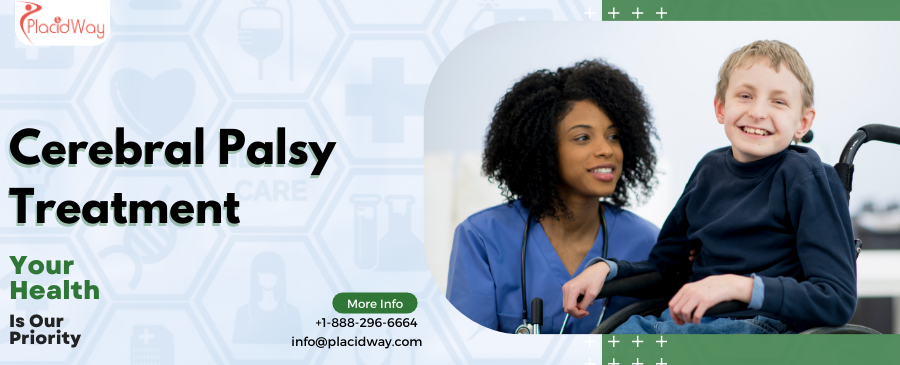
Discovering Hope: Advanced Cerebral Palsy Treatment Options Abroad
Living with or caring for someone with Cerebral Palsy (CP) presents unique challenges, often marked by difficulties with movement, muscle control, and coordination. As families navigate this journey, the quest for effective treatments and therapies is ongoing, aiming to improve mobility, reduce pain, and enhance overall quality of life. For many, the answer lies beyond local borders, in the specialized clinics and innovative treatments offered through medical tourism.
Cerebral Palsy is a condition that impacts individuals differently, ranging from mild motor impairments to severe physical disabilities. It stems from abnormal brain development or damage to the developing brain, often before or during birth. While CP is a permanent condition, its effects are not static, and with proactive intervention, significant improvements can be achieved. Treatments are highly individualized, targeting specific symptoms and needs.
Today, a growing number of patients and their families are exploring international healthcare options for Cerebral Palsy. This includes seeking out pioneering surgical techniques like Selective Dorsal Rhizotomy (SDR), innovative stem cell therapies, and comprehensive rehabilitation programs that may not be readily available or affordable in their home countries. Understanding the symptoms, causes, and a wide array of treatment choices is the first step toward making an informed decision about seeking care abroad.
This guide aims to provide a comprehensive overview of Cerebral Palsy, its treatments, and the considerations involved in pursuing medical care internationally. We'll delve into common search queries like "cerebral palsy treatment options," "new treatments for cerebral palsy," and "cost of CP therapy abroad" to help you find the answers you need.
What are the common symptoms of Cerebral Palsy?
Cerebral Palsy manifests in various ways, primarily affecting movement and posture. The specific "Cerebral Palsy signs in children" and adults depend on which part of the brain was damaged and the extent of that damage. Here are some common symptoms:
- Spasticity: Stiff muscles and exaggerated reflexes, leading to awkward movements. This is the most common type of CP.
- Ataxia: Poor balance and coordination, leading to unsteady walking or difficulty with precise movements.
- Athetosis/Dyskinesia: Involuntary, slow, writhing movements, often affecting the hands, feet, arms, or legs.
- Hypotonia: Floppy muscles, making the individual appear relaxed or weak.
- Delayed Motor Skill Milestones: Not sitting up, crawling, or walking at typical ages.
- Difficulty with Fine Motor Skills: Challenges with tasks like writing, buttoning clothes, or picking up small objects.
- Speech and Swallowing Difficulties: Known as dysarthria and dysphagia, respectively.
- Other Associated Conditions: Seizures, vision or hearing problems, intellectual disabilities, learning difficulties, and pain.
Early recognition of these "early symptoms of CP" is crucial for timely intervention and improved outcomes.
What causes Cerebral Palsy and what are its risk factors?
The core "causes of CP" revolve around damage to the developing brain. This damage can occur at various stages:
- Prenatal (Before Birth):
- Maternal infections (e.g., rubella, toxoplasmosis, Zika virus).
- Stroke in the fetus (impaired blood flow to the developing brain).
- Genetic mutations affecting brain development.
- Exposure to toxins during pregnancy.
- Severe jaundice.
- Perinatal (During Birth):
- Lack of oxygen to the brain during labor and delivery (asphyxia).
- Complicated labor, leading to birth trauma.
- Postnatal (Shortly After Birth, typically within the first few years):
- Severe head injuries.
- Infections like meningitis or encephalitis.
- Near drowning.
- Stroke.
Understanding these "risk factors for Cerebral Palsy" is important, though often the exact cause in an individual case remains unknown.
What types of treatments and therapies are available for Cerebral Palsy?
Managing Cerebral Palsy involves a comprehensive approach, often combining several "CP treatment options" to address individual needs. The goal is to improve function, reduce pain, and enhance independence.
Conventional Therapies:
- Physical Therapy (PT): Focuses on improving strength, flexibility, balance, and motor skills. This is fundamental for children learning to walk or improving their gait.
- Occupational Therapy (OT): Helps individuals develop skills for daily living, such as dressing, eating, and school activities.
- Speech and Language Therapy (SLT): Addresses communication difficulties and swallowing problems.
- Medications: Muscle relaxants (e.g., Baclofen, Tizanidine) to reduce spasticity, anti-seizure medications, and botulinum toxin (Botox) injections to specific muscles to reduce stiffness.
- Orthopedic Surgery: Corrects bone deformities, releases tight muscles, or lengthens tendons to improve mobility.
Advanced and Emerging Treatments:
- Selective Dorsal Rhizotomy (SDR) Surgery: A neurosurgical procedure that selectively cuts problematic sensory nerve roots in the spinal cord to permanently reduce severe spasticity in the legs. Many patients search for "SDR surgery for CP" specifically abroad.
- Stem Cell Therapy for Cerebral Palsy: An investigational treatment aimed at repairing damaged brain tissue or reducing inflammation. While not yet standard, it's a focus of significant research and a key reason many travel for "new treatments for cerebral palsy."
- Hyperbaric Oxygen Therapy (HBOT): Involves breathing pure oxygen in a pressurized chamber, which is believed by some to improve brain function and reduce inflammation.
- Intrathecal Baclofen Pump (ITB): A surgically implanted device that delivers Baclofen directly to the spinal fluid for generalized spasticity.
Each of these "therapies for Cerebral Palsy" has specific indications and potential benefits, making personalized assessment essential.
Who is eligible for Cerebral Palsy treatments abroad?
The question "who can get SDR surgery" or "who is eligible for stem cell therapy for CP" is crucial for patients considering treatment abroad. Eligibility criteria are highly specific to the procedure:
- For SDR Surgery: Typically, children between 3-10 years old with severe spasticity primarily affecting the legs, good underlying muscle strength, and no significant dystonia or scoliosis. Comprehensive pre-operative evaluation, including MRI and video gait analysis, is essential.
- For Stem Cell Therapy: Criteria are still evolving as it's an experimental treatment. Generally, patients of various ages with stable CP, without active infections or other severe medical conditions. Clinics often require detailed medical records and sometimes specific diagnostic tests.
- For General Rehabilitation/Therapies: Most individuals with CP can benefit, regardless of age or severity. The focus is on finding programs tailored to their specific functional goals.
- Overall Health: Patients must be medically stable enough to travel and undergo the chosen procedure. Any underlying conditions like heart problems or uncontrolled seizures could affect eligibility.
Reputable international clinics will require extensive medical records and often conduct virtual consultations to assess suitability before travel.
What recovery time and expectations should you have after Cerebral Palsy treatment?
Understanding "recovery after SDR surgery" or the long-term commitment of "Cerebral Palsy therapy recovery" is vital for managing expectations. CP treatment is rarely a one-time fix; it's an ongoing process:
- After SDR Surgery: This is a major commitment. Patients typically require 3-6 weeks of immediate post-operative rehabilitation in the hospital or a specialized center, followed by several months to even years of intensive outpatient physical therapy (e.g., 3-5 times a week). Improvements in spasticity are immediate, but functional gains (like walking independently) are gradual and depend on dedicated therapy.
- After Orthopedic Surgery: Recovery involves casts, braces, and weeks to months of physical therapy, depending on the complexity of the procedure.
- After Stem Cell Therapy: While the procedure itself might involve minimal downtime, the observed improvements are often gradual, occurring over several months. Continued traditional therapies are usually recommended to maximize potential benefits.
- Ongoing Therapies (PT, OT, SLT): These are often lifelong endeavors, adapting as the individual grows and their needs change. Consistency and home exercise programs are key to maintaining and improving function.
Realistic expectations mean understanding that while improvements are possible, CP is a chronic condition requiring continuous management.
What are the potential risks and side effects of Cerebral Palsy treatments?
It's important to be aware of the "risks of SDR surgery," "side effects of CP medication," and other potential drawbacks of various interventions:
- SDR Surgery Risks:
- Spinal fluid leak, infection, bleeding.
- Temporary or permanent sensory loss, weakness, or bladder dysfunction.
- Hypotonia (excessive muscle floppiness) if too many nerve roots are cut.
- Residual pain or discomfort.
- Medication Side Effects:
- Oral muscle relaxants can cause drowsiness, fatigue, or gastrointestinal issues.
- Botox injections can lead to temporary weakness in the injected muscle, bruising, or flu-like symptoms.
- Intrathecal Baclofen pumps carry surgical risks and potential pump malfunctions or overdose/withdrawal symptoms.
- Stem Cell Therapy Risks: As an experimental treatment, long-term risks are still being studied. Potential immediate risks include infection at the injection site, allergic reactions, and theoretical risks of tumor formation (though rarely observed in studies for CP). There's also the risk of financial burden for an unproven therapy.
- Orthopedic Surgery Risks: Standard surgical risks like infection, bleeding, anesthesia complications, and potential for recurrence of the deformity.
A thorough discussion with medical professionals about potential benefits versus risks is crucial for informed decision-making.
How do Cerebral Palsy treatment costs compare worldwide?
The "cost of Cerebral Palsy treatment" is a significant factor for many families, driving the search for "SDR surgery cost abroad" and "stem cell therapy CP cost" comparisons. Here's a general overview, noting that prices can fluctuate based on clinic, surgeon experience, and specific patient needs:
| Procedure/Treatment | USA/Western Europe (Estimated) | Medical Tourism Destinations (e.g., Turkey, India, Mexico) (Estimated) | Potential Savings |
|---|---|---|---|
| Selective Dorsal Rhizotomy (SDR) Surgery (including hospital stay, not rehab) | $50,000 - $100,000+ | $15,000 - $35,000 | 50-75% |
| Stem Cell Therapy (per course/injection) | Not widely available/Covered, potentially $20,000 - $50,000+ for clinical trials or private clinics | $8,000 - $25,000 | Significant |
| Orthopedic Surgery (e.g., tendon lengthening) | $15,000 - $40,000+ | $5,000 - $15,000 | 50-70% |
| Intensive Rehabilitation Program (e.g., 3-4 weeks) | $10,000 - $25,000+ | $3,000 - $10,000 | 50-70% |
These figures are estimates and do not include travel, accommodation, or extensive post-operative rehabilitation which often needs to be factored in. The significant "medical tourism for Cerebral Palsy" savings often make it a viable option for many.
Why consider traveling abroad for Cerebral Palsy treatment?
The decision to seek "Cerebral Palsy treatment abroad" is often driven by a combination of compelling factors:
- Cost-Effectiveness: As seen in the table above, the primary driver for many is the substantial cost savings compared to private care in countries like the USA, Canada, or the UK. Even with travel and accommodation, the overall expense can be considerably lower.
- Access to Advanced Therapies: Some pioneering treatments, particularly experimental ones like certain stem cell protocols or highly specialized rehabilitation programs, might be more accessible or only available in certain countries.
- Reduced Wait Times: In countries with universal healthcare, long waiting lists for certain surgeries or specialized therapies can delay critical intervention. Medical tourism often provides quicker access to care.
- Specialized Expertise: Certain clinics and surgeons abroad are globally recognized for their expertise in specific areas of Cerebral Palsy treatment, such as SDR surgery or intensive neurorehabilitation.
- Comprehensive Packages: Many international hospitals offer all-inclusive packages that cover medical procedures, accommodation, airport transfers, and even interpreter services, simplifying the patient experience.
For families seeking the "best countries for CP treatment," these benefits often outweigh the challenges of international travel.
Which countries offer the best value for Cerebral Palsy treatment?
When considering "medical tourism for Cerebral Palsy," certain destinations stand out for their combination of quality, affordability, and accessibility:
- Turkey: Known for its modern hospitals, experienced neurologists and orthopedic surgeons, particularly for SDR surgery and rehabilitation. Prices are highly competitive, and Istanbul is a major hub.
- India: A leading destination for medical tourism, offering state-of-the-art facilities, highly skilled doctors, and a wide range of treatments including neurosurgery, stem cell therapy, and comprehensive rehabilitation at a fraction of Western costs.
- Mexico: Popular for North American patients due to proximity. Offers a growing number of specialized clinics for stem cell therapies and rehabilitation programs.
- Thailand: Renowned for its hospitality and high-quality medical infrastructure, especially in Bangkok. Offers excellent rehabilitation services and conventional treatments.
- South Korea: Emerging as a hub for advanced medical technologies, including innovative rehabilitation and research-backed treatments, though costs might be slightly higher than other Asian counterparts.
These countries often have a well-developed medical tourism infrastructure, including English-speaking staff and support services for international patients.
How can you ensure safety and quality when seeking CP treatment abroad?
Ensuring "safe medical tourism for Cerebral Palsy" and high-quality care is paramount. Here’s what to look for:
- Accreditation: Look for international accreditations such as Joint Commission International (JCI). This signifies that a facility meets stringent international standards for patient safety and quality of care.
- Surgeon and Specialist Credentials: Verify the qualifications, experience, and specialization of the doctors. Many top international surgeons have received training in Western countries. Ask about their specific experience with Cerebral Palsy patients and the procedures you are considering.
- Patient Reviews and Testimonials: Seek out "patient success stories from abroad" for the specific clinic and procedure. Online forums, patient advocacy groups, and medical tourism platforms can be valuable resources.
- Transparent Communication: The clinic should provide clear, detailed information about the treatment plan, costs, potential risks, and expected outcomes in your language.
- Comprehensive Evaluation: A good clinic will require a thorough review of your medical records, possibly including remote consultations, before recommending a treatment plan.
- Medical Tourism Facilitators: Companies like PlacidWay specialize in connecting patients with reputable international providers, helping with research, logistics, and ensuring a smooth, safe experience. They vet clinics and act as a liaison.
- Post-Treatment Care Plan: Understand what follow-up care is provided by the international clinic and how your local doctors can integrate the treatment into ongoing care.
Thorough research and due diligence are your best tools for a successful and safe medical journey abroad.
Take the Next Step with PlacidWay
Ready to explore treatment options abroad? Discover top clinics, compare prices, and get a free quote tailored to your needs with PlacidWay.
Best Neurology Treatment Center | Cheap Neurology Treatment Packages










Share this listing